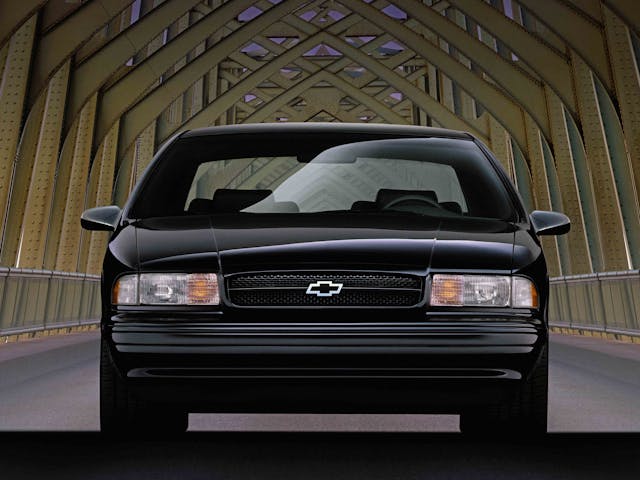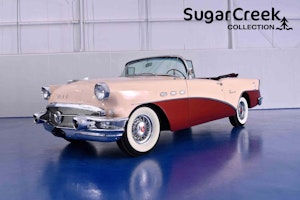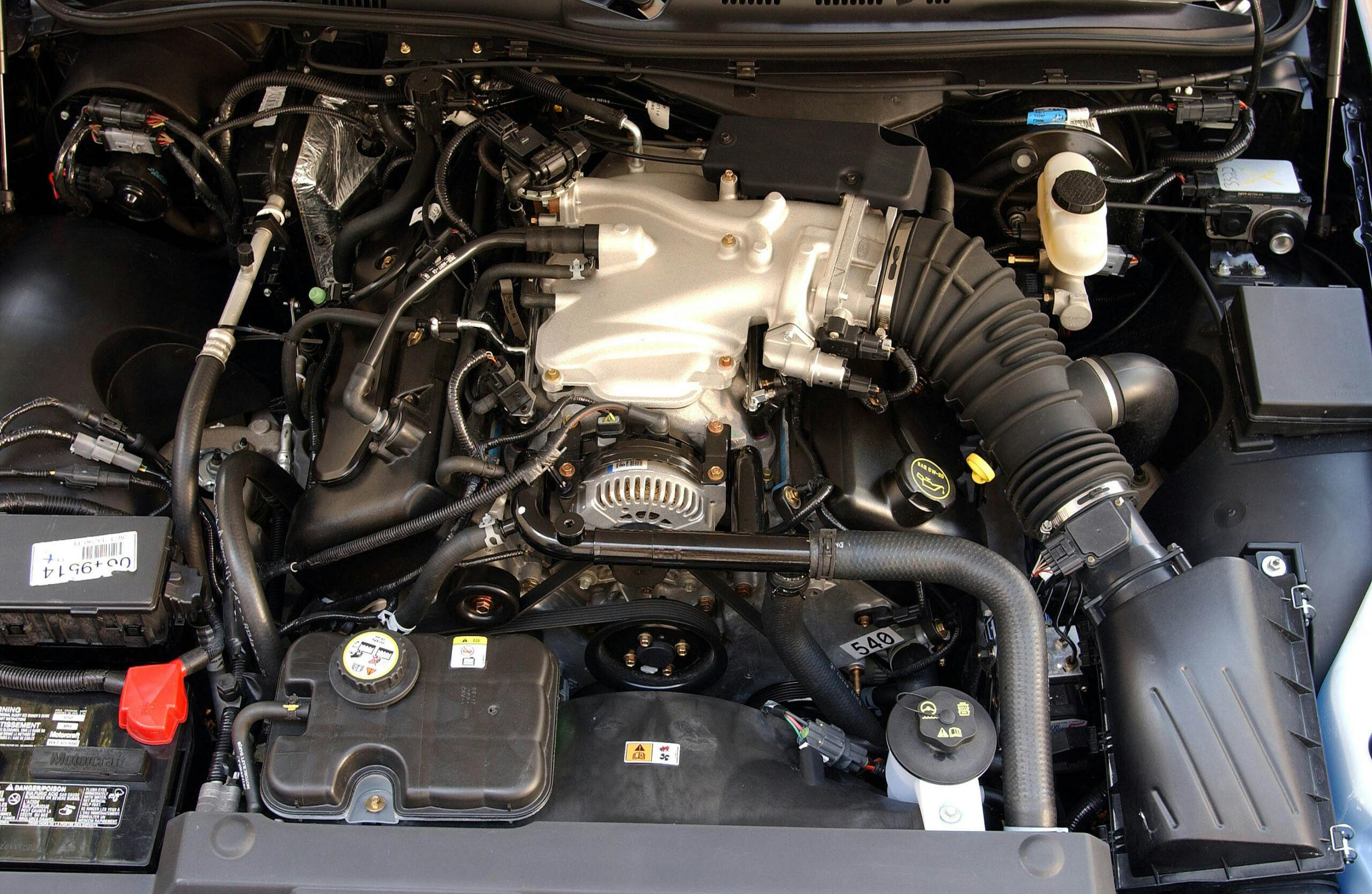Media | Articles
The Chevy Impala SS and Mercury Marauder are classic American sleepers
For a beautiful time in the 1950s, ’60s, and ’70s, automakers had imagination, family cars looked stunning, and if you had the extra coin, you could spec them with some real power under the hood.
Fast forward to the 1990s, and most of the excitement had long since left the family-hauling slice of the new-car market. We were in full transition mode, from an era of boxes on wheels to one of jellybeans on wheels. Sure, there were still fun cars to be had, but most of them weren’t exactly practical to own and drive on a daily basis.
As the decade came to a close and SUVs and crossovers replaced full-size cars as family haulers, there were still a few holdouts roaming the streets—big, V-8-powered, rear-wheel-drive machines. Your Grand Marquis, Crown Victorias, and Caprices, even the Roadmaster. They came with a live rear axle and enough room for the family, and they made for perfectly boring commuter cars.
Though the segment slowly died out, two platforms soldiered on—the GM B-body and Ford’s Panther. Both sported underpinnings dating back to the late 1970s, with enough design changes and drivetrain updates over the years to keep them relevant. That said, enthusiasts and people who remembered big-bodied performance from decades before weren’t paying much attention to either platform.
Then came two swan song specials. Today we owe some thanks to those performance die hards within the industry who took two of the blandest family cars on earth and turned them into a duo we never asked for but needed so badly: The Chevrolet Impala SS and the Mercury Marauder.
Marketplace
Buy and sell classics with confidence
Chevrolet Impala SS

General Motors gave the full-size B-body a total redesign in 1991. Visually, the changes were night and day, with the old sharp-edged boxy body giving way to a whale on wheels. But that’s where the differences ended. Underneath, the chassis remained nearly identical to the one introduced in 1977. A year later, however, that would all change, when Chevrolet introduced its Impala SS concept at the Detroit auto show. The brainchild of designer Jon Moss, the concept took a standard Caprice, blacked out all the trim, and stuffed a 510-cubic-inch V-8 engine under the hood. By 1994, the first Impala SS production cars were rolling off the assembly line, 25 years after the name had been canceled.
As with any production car, the final product was different from the concept. The big-block was replaced by the powerful-for-the-time 350-cubic-inch LT1 V-8, which made 260 hp. An upgraded suspension came from the 9C1 package used for police cars, a limited-slip differential was installed, and the rear brakes were upgraded to discs. Exterior designers did the best they could with what they had to work with, which simply meant a total lack of chrome, a set of big five-spoke wheels, and a lowered stance. It was all just menacing enough.
Performance was decent for the time, with 0 to 60 mph coming in around 7 seconds—not too shabby for a two-ton monster. By today’s standards, of course, such a figure can be achieved by most daily drivers. But in the context of the era, it was some feat. Sales topped 69,000 units in just three years of production.
These Impalas are relatively robust cars. That’s the benefit of that tried-and-true chassis. In fact, the biggest gripes are common to the LT1 engine. The Optispark ignition system sits under the water pump and can be problematic—and difficult to replace. By this point, however, most cars with the issue have already had it addressed with upgraded parts. The only other glaring issue is the car’s interior, as GM interior quality from the 1990s is not great, and the leather upholstery wears quickly. A low-mile, low-use example is the best way around this issue; otherwise, an interior refresh might be in the cards.
Mercury Marauder

Based on the fourth generation of the Ford Panther platform, the Mercury Marauder follows a similar trajectory to that of the Impala SS, which preceded it by a decade. The Panther is another full-frame, full-size, rear-wheel-drive platform dating to the late 1970s. Much like the GM B-body, it was also popular for underpinning full-size commuter cars as well as fleet and police cars.
The Marauder made its first appearance at the 2002 Chicago auto show as a concept car sporting a supercharged 4.6-liter V-8. Sadly, like the Impala SS concept, the Marauder would be toned down somewhat when it entered production in 2003. Similar to the Impala SS improvements, the Grand Marquis–based Marauder came with a monochromatic paint scheme, an upgraded suspension from the Crown Victoria’s Police Interceptor package, and a stronger driveline.
Output was rated at 302 hp, thanks to the four-valve 4.6-liter Modular V-8 also used in the Mustang Mach 1. The rear axle had a 3.55:1 ratio with a limited-slip differential, versus the Impala’s 3.08:1, and the Marauder tipped the scales at 4200 pounds. It made the sprint from 0 to 60 mph in 7.5 seconds, half a second slower than the Impala, despite having the horsepower and gearing advantage. Unfortunately for enthusiasts, the Marauder was canceled after just two years and production of just over 11,000 cars.
Reliability isn’t an issue in these cars. Like the Impala, the Marauder sits on a proven platform, so serious issues are not common. Most problems center on issues common to the Ford Modular engine—coolant leaks and misfires due to compression loss. As with the Impala’s LT1, by this point, such issues have likely been addressed. Other reported pitfalls have to do with blistering paint and headlight malfunctions.
What’s the market for these cars?
Digging into who is buying these cars yielded some surprising results. Being so similar in styling and purpose, it would be easy to assume that both cars have the same type of buyer. That’s not the case. We found that the overwhelming majority of Impala SS owners are Gen X, while Baby Boomers prefer the Marauder, with a nearly equal amount of interest in both cars from Millennials. It is also worth pointing out that with more than six times the number of Impalas produced, there is far more activity surrounding the Impala.
Values, however, are neck and neck, with the Impala being the slightly more expensive option. A #2 condition (Excellent) Impala SS will run you under $30,000, while a driver-quality #3 (Good) car is still in the mid-teens. Looking at the Marauder, a #2 condition (Excellent) example will cost a hair over $20,000, while a driver-quality #3 (Good) car can be had for around $12,000.
All things considered, this is a lot of bang for the buck to get into a collector car. Granted, by today’s standards, each looks far more badass than they are fast, but both were considered legit performance cars of their time, and they will still turn heads. Even when you’re just out running errands with the family.
***
Check out the Hagerty Media homepage so you don’t miss a single story, or better yet, bookmark it. To get our best stories delivered right to your inbox, subscribe to our newsletters.
Via Hagerty Insider





















Not sure……?
Not sure………..?
I have driven both cars and would take the Chevrolet in a minute if for no other reason than design. The Ford
looks like a Ford, a Crown Victoria now a Mercury with different front and rear clips and interior. Frankly, the Mercury design is disappointing. Which is why I’d take the Chevrolet. One other thing: I took a bunch of people to Lunch in the Impala and the back seat was very roomy. I did the same thing with the Mercury and somehow the rear seat was not as wide. Maybe it’s just a Passenger complaint.
I could’ve bought a Marauder in 2010 for $8k! Dammit! Should’ve grabbed it.
I know this dog ain’t in this hunt, but- 2016/2017 Chevrolet (Holden) SS with a 6-speed is my first choice. Although the price is nuts. Marquis next , Chevy SS a distant third.
Which Chevy SS are you referring to, might I ask? The Impala SS in the article, or the Aussie Holden Commodore rebadged first as a 2008-2009 Pontiac G8, only to be rebadged a second time as a 2014-2017 Chevy SS after Pontiac’s demise?
The Holden . It was a nicely-sized car with a ton of performance. GM did what they normally did with cars such as the G8. They put it and the SS in the Witness Protection Program. I saw an SS on the road here in Rochester,NY last week. Of course, an “older” gentleman was behind the wheel. He appeared to be using the car as it was intended to be used.
A 1995-1996 Roadmaster Estate beats both. More of a sleeper and more room for friends. If a drunk driver hadn’t totaled mine, I would still be driving it.
Fat, ugly and slow. My Mercedes C280’s inline 6 would walk away from a stock one. A modified one could not even be licensed in CA unless it had an EO approved supercharger. Problematic engine setup for the Chevy, soda straw ports in the Modular V8. Don’t even get me started about the cheap interior fittings…
I saw the appeal of these cars when they were new, and tried both and came away disappointed. Nearly 40 years later, I still have the W202, and it is as tight as it was when new.
I was member #11 in the National Association of 1994-1996 Impala SS Owners Club. This club eventually became over 5,000 member strong. i have logged over 150K miles in 2 separate 1995 grey/green Impales.My water pump never leaked and optispark never failed. Because, you have to change coolant every 3yrs or 30kmiles religiously. Always use toptier fuels. I don’t race my 2nd Impala ss and it handles beautifully on tire size P235/55r17 tires.At 70mph, I am actually going 69mph.Greater selection of tires and handles extremely well with H-rated michelin tires as long as you are not racing it around corners. My engine and driveline mods have increased engine to 400hp. However, the LT-1 breathes, fuels more efficiently. Last time I did a controlled 100 mile highway gas mileage check with BP 93 octane gas with cruise control set at 72 mph, I got 23.8 MPG.
Back in ’96 I ordered a black Impala SS. To me, that was the best year as they installed the analog speedometer and tach along with putting the shifter in the console. I loved driving that car. The best I could pull at Island Dragway (Great Meadows, NJ) was a 15.50 on a hot July evening.
I’m now the proud owner of a black ’17 Chevrolet SS equipped with the LS3 V8, six speed manual and 3:30 rear. The previous owner added a set of Kooks long tube headers. Talk about a sleeper.
Correction: a 3:70 rear, not 3:30
I have a 96 SS that i bought new. Has a little over 80000 miles. Been trouble free but interior has a couple of 2 inch tears, so will need replacing soon. It has a superchip and K&N filter but rest is stock. Great road car, 25 plus MPG, rides and handles very well and faster than most even today. My grandson likes laying down (stripes).
I think that Ford made two (2), possibly three (3) mistakes with the Marauder. First, power wasn’t quite living up to expectations, but a supercharger can fix that in short order, and has for some of these cars via the aftermarket. Second, I think that Ford missed the chance to significantly upgrade the handling by not fitting the Independent Rear Suspension (IRS) setup from the contemporary stablemate, the 2002-2010 Ford Explorer. Finally, I wish that the Mercury Marauder Convertible Show Car had made it to production! Imagine, the last body-on-frame Convertible for sale in the USA, if not the World! Here’s a Link:
https://www.caranddriver.com/news/a15137079/mercury-marauder-convertible-concept-auto-shows/
The Marauder definitely needs more bottom end, I have 411 gears and headers which help but agree a supercharger is the way to go.
Marauder……….more sinister looking by far. My choice Pontiac G-8
I doubt either of these barges could keep up with a 1998-2000 SVT Contour on a crooked road. Looked similar to the signature car of the single mother, but with 200 hp at 6700 rpm and a computer-limited top speed of 144 mph, it was the most fun car I ever had. Its greatest downfall was the lack of parts support by parent Ford. The most fun car I’ve had.
I always thought the Chevy looked like a pregnant cow from the rear.
The 2006-2009 Cadillac STS-V is the forgotten sedan sleeper. It’s never mentioned in the enthusiast automotive media.